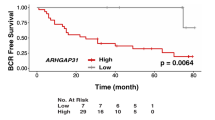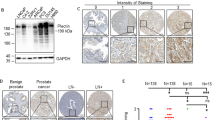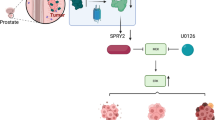Abstract
Multiple lines of evidence have provided compelling evidence for the existence of a tumor suppressor gene (TSG) on chromosome 7q31.1. ST7 may be the target of this genetic instability but its designation as a TSG is controversial. In this study, we show that, functionally, ST7 behaves as a tumor suppressor in human cancer. ST7 suppressed growth of PC-3 prostate cancer cells inoculated subcutaneously into severe combined immunodeficient mice, and increased the latency of tumor detection from 13 days in control tumors to 23 days. Re-expression of ST7 was also associated with suppression of colony formation under anchorage-independent conditions in MDA-MB-231 breast cancer cells and ST7 mRNA expression was downregulated in 44% of primary breast cancers. Expression profiling of PC-3 cells revealed that ST7 predominantly induces changes in genes involved in re-modeling the extracellular matrix such as SPARC, IGFBP5 and several matrix metalloproteinases. These data indicate that ST7 may mediate tumor suppression through modification of the tumor microenvironment.
This is a preview of subscription content, access via your institution
Access options
Subscribe to this journal
Receive 50 print issues and online access
$259.00 per year
only $5.18 per issue
Buy this article
- Purchase on Springer Link
- Instant access to full article PDF
Prices may be subject to local taxes which are calculated during checkout




Similar content being viewed by others
Accession codes
References
Achille A, Biasi MO, Zamboni G, Bogina G, Magalini AR, Pederzoli P et al. (1996). Cancer Res 56: 3808–3813.
Barker TH, Baneyx G, Cardo-Vila M, Workman GA, Weaver M, Menon PM et al. (2005a). J Biol Chem 280: 36483–36493.
Barker TH, Framson P, Puolakkainen PA, Reed M, Funk SE, Sage EH . (2005b). Am J Pathol 166: 923–933.
Bieche I, Champeme MH, Matifas F, Hacene K, Callahan R, Lidereau R . (1992). Lancet 339: 139–143.
Brekken RA, Puolakkainen P, Graves DC, Workman G, Lubkin SR, Sage EH . (2003). J Clin Invest 111: 487–495.
Brown VL, Proby CM, Barnes DM, Kelsell DP . (2002). Br J Cancer 87: 208–211.
Chin D, Boyle GM, Williams RM, Ferguson K, Pandeya N, Pedley J et al. (2005). Int J Cancer 113: 789–797.
Chlenski A, Liu S, Baker LJ, Yang Q, Tian Y, Salwen HR et al. (2004). Cancer Res 64: 7420–7425.
Dennis Jr G, Sherman BT, Hosack DA, Yang J, Gao W, Lane HC et al. (2003). Genome Biol 4: P3.
Dong SM, Sidransky D . (2002). Clin Cancer Res 8: 2939–2941.
Hughes KA, Hurlstone AF, Tobias ES, McFarlane R, Black DM . (2001). Nat Genet 29: 380–381.
Jones C, Mackay A, Grigoriadis A, Cossu A, Reis-Filho JS, Fulford L et al. (2004). Cancer Res 64: 3037–3045.
Kato Y, Tsukuda M, Nagashima Y, Koshika S, Sakai N, Yao M et al. (2005). Int J Oncol 27: 759–768.
Katoh M . (2002). Int J Oncol 20: 1247–1253.
Koike M, Takeuchi S, Yokota J, Park S, Hatta Y, Miller CW et al. (1997). Genes Chromosomes Cancer 19: 1–5.
Koukourakis MI, Giatromanolaki A, Brekken RA, Sivridis E, Gatter KC, Harris AL et al. (2003). Cancer Res 63: 5376–5380.
Kruzelock RP, Cuevas BD, Wiener JR, Xu FJ, Yu Y, Cabeza-Arvelaiz Y et al. (2000). Oncogene 19: 6277–6285.
Latil A, Cussenot O, Fournier G, Baron JC, Lidereau R . (1995). Clin Cancer Res 1: 1385–1389.
Le Bail B, Faouzi S, Boussarie L, Guirouilh J, Blanc JF, Carles J et al. (1999). J Pathol 189: 46–52.
Lu C, Xu HM, Ren Q, Ao Y, Wang ZN, Ao X et al. (2003). World J Gastroenterol 9: 2662–2665.
Lussier C, Sodek J, Beaulieu JF . (2001). J Cell Biochem 81: 463–476.
Moschos SJ, Mantzoros CS . (2002). Oncology 63: 317–332.
Ogata T, Ayusawa D, Namba M, Takahashi E, Oshimura M, Oishi M . (1993). Mol Cell Biol 13: 6036–6043.
Pal S, Vishwanath SN, Erdjument-Bromage H, Tempst P, Sif S . (2004). Mol Cell Biol 24: 9630–9645.
Palmer RE, Kotsianti A, Cadman B, Boyd T, Gerald W, Haber DA . (2001). Curr Biol 11: 1805–1809.
Paoni NF, Feldman MW, Gutierrez LS, Ploplis VA, Castellino FJ . (2003). Physiol Genomics 15: 228–235.
Puolakkainen PA, Brekken RA, Muneer S, Sage EH . (2004). Mol Cancer Res 2: 215–224.
Rosenblatt S, Bassuk JA, Alpers CE, Sage EH, Timpl R, Preissner KT . (1997). Biochem J 324: 311–319.
Sassetti C, Tangemann K, Singer MS, Kershaw DB, Rosen SD . (1998). J Exp Med 187: 1965–1975.
Shih SC, Robinson GS, Perruzzi CA, Calvo A, Desai K, Green JE et al. (2002). Am J Pathol 161: 35–41.
Shridhar V, Sun QC, Miller OJ, Kalemkerian GP, Petros J, Smith DI . (1997). Oncogene 15: 2727–2733.
Stanhope-Baker P, Kessler PM, Li W, Agarwal ML, Williams BR . (2004). J Biol Chem 279: 33575–33585.
Takahashi S, Shan AL, Ritland SR, Delacey KA, Bostwick DG, Lieber MM et al. (1995). Cancer Res 55: 4114–4119.
Thomas NA, Choong DY, Jokubaitis VJ, Neville PJ, Campbell IG . (2001). Nat Genet 29: 379–380.
Thomas R, True LD, Bassuk JA, Lange PH, Vessella RL . (2000). Clin Cancer Res 6: 1140–1149.
Vincent JB, Herbrick JA, Gurling HM, Bolton PF, Roberts W, Scherer SW . (2000). Am J Hum Genet 67: 510–514.
Vincent JB, Petek E, Thevarkunnel S, Kolozsvari D, Cheung J, Patel M et al. (2002). Genomics 80: 283–294.
Yiu GK, Chan WY, Ng SW, Chan PS, Cheung KK, Berkowitz RS et al. (2001). Am J Pathol 159: 609–622.
Zenklusen JC, Bieche I, Lidereau R, Conti CJ . (1994a). Proc Natl Acad Sci USA 91: 12155–12158.
Zenklusen JC, Conti CJ, Green ED . (2001). Nat Genet 27: 392–398.
Zenklusen JC, Hodges LC, LaCava M, Green ED, Conti CJ . (2000). Oncogene 19: 1729–1733.
Zenklusen JC, Oshimura M, Barrett JC, Conti CJ . (1994b). Oncogene 9: 2817–2825.
Zenklusen JC, Thompson JC, Klein-Szanto AJ, Conti CJ . (1995a). Cancer Res 55: 1347–1350.
Zenklusen JC, Thompson JC, Troncoso P, Kagan J, Conti CJ . (1994c). Cancer Res 54: 6370–6373.
Zenklusen JC, Weitzel JN, Ball HG, Conti CJ . (1995b). Oncogene 11: 359–363.
Zhang JS, Nelson M, McIver B, Hay ID, Goellner JR, Grant CS et al. (1998). Oncogene 17: 789–793.
Acknowledgements
We thank the staff of the Peter MacCallum Cancer Centre Microarray Facility and Christina Restall for technical assistance. This work was supported by a grant from the Cancer Council of Victoria.
Author information
Authors and Affiliations
Corresponding author
Additional information
Supplementary Information accompanies the paper on Oncogene website (http://www.nature.com/onc)
Supplementary information
Rights and permissions
About this article
Cite this article
Hooi, CF., Blancher, C., Qiu, W. et al. ST7-mediated suppression of tumorigenicity of prostate cancer cells is characterized by remodeling of the extracellular matrix. Oncogene 25, 3924–3933 (2006). https://doi.org/10.1038/sj.onc.1209418
Received:
Revised:
Accepted:
Published:
Issue Date:
DOI: https://doi.org/10.1038/sj.onc.1209418
Keywords
This article is cited by
-
The characterization of an intestine-like genomic signature maintained during Barrett’s-associated adenocarcinogenesis reveals an NR5A2-mediated promotion of cancer cell survival
Scientific Reports (2016)
-
Localization and characterization of ST7 in cancer
Journal of Cancer Research and Clinical Oncology (2011)
-
Multivariate gene expression analysis reveals functional connectivity changes between normal/tumoral prostates
BMC Systems Biology (2008)



